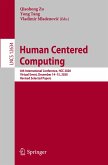Ambient Intelligence (AmI) is an integrating technology for supporting a pervasive and transparent infrastructure for implementing smart environments. Such technology is used to enable environments for detecting events and behaviors of people and for responding in a contextually relevant fashion. AmI proposes a multi-disciplinary approach for enhancing human machine interaction.
Ambient Intelligence: A Novel Paradigm is a compilation of edited chapters describing current state-of-the-art and new research techniques including those related to intelligent visual monitoring, face and speech recognition, innovative education methods, as well as smart and cognitive environments.
The authors start with a description of the iDorm as an example of a smart environment conforming to the AmI paradigm, and introduces computer vision as an important component of the system. Other computer vision examples describe visual monitoring for the elderly, classic and novel surveillance techniques using clusters of cameras installed in indoor and outdoor application domains, and the monitoring of public spaces. Face and speech recognition systems are also covered as well as enhanced LEGO blocks for novel educational purposes. The book closes with a provocative chapter on how a cybernetic system can be designed as the backbone of a human machine interaction.
Ambient Intelligence: A Novel Paradigm is a compilation of edited chapters describing current state-of-the-art and new research techniques including those related to intelligent visual monitoring, face and speech recognition, innovative education methods, as well as smart and cognitive environments.
The authors start with a description of the iDorm as an example of a smart environment conforming to the AmI paradigm, and introduces computer vision as an important component of the system. Other computer vision examples describe visual monitoring for the elderly, classic and novel surveillance techniques using clusters of cameras installed in indoor and outdoor application domains, and the monitoring of public spaces. Face and speech recognition systems are also covered as well as enhanced LEGO blocks for novel educational purposes. The book closes with a provocative chapter on how a cybernetic system can be designed as the backbone of a human machine interaction.
From the reviews: "This book is a collection of edited chapters that describe current and emerging research techniques that show promise for AmI. ... This book provides a useful introduction to AmI, particularly for those with an interest in computer vision. The writing and organization are good." (M.G. Murphy, Computing Reviews, February, 2005)








